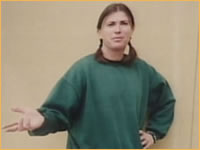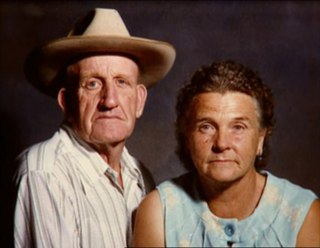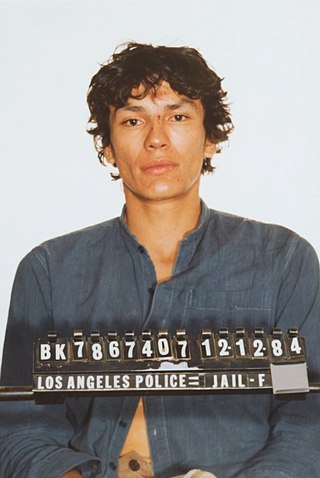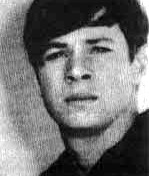
A serial killer is typically a person who murders three or more persons, with the murders taking place over more than a month and including a significant period of time between them. While most authorities set a threshold of three murders, others extend it to four or lessen it to two.

San Quentin Rehabilitation Center (SQ), formerly known as San Quentin State Prison, is a California Department of Corrections and Rehabilitation state prison for men, located north of San Francisco in the unincorporated place of San Quentin in Marin County.

Joseph Paul Franklin was an American neo-Nazi terrorist and serial killer who engaged in a murder spree spanning the late 1970s and early 1980s.

Herbert William Mullin was an American serial killer who killed 13 people in California in the early 1970s. He confessed to the killings, which he claimed prevented earthquakes. In 1973, after a trial to determine whether he was legally insane or culpable, he was convicted of two murders in the first-degree and nine in the second-degree, and sentenced to life imprisonment. During his imprisonment, he was denied parole eight times.
This is a timeline of major crimes in Australia.

Paul Charles Denyer is an Australian serial killer currently serving three consecutive sentences of life imprisonment with a non-parole period of 30 years for the murders of three young women in Melbourne, in 1993. Denyer became known in the media as the Frankston Serial Killer as his crimes occurred in the neighbouring suburbs of Frankston.

Faye Della Copeland and Ray Copeland became, at the ages of 69 and 76 respectively, the oldest couple ever sentenced to death in the United States. They were convicted of killing five drifters at their farm in Mooresville, Missouri. When her sentence was commuted to life in prison in 1999, Faye Copeland was the oldest woman on death row.

Donald Henry "Pee Wee" Gaskins Jr. was an American serial killer and rapist from South Carolina who stabbed, shot, drowned, and poisoned more than a dozen people. Before his convictions for murder, Gaskins had a long history of criminal activities resulting in prison sentences for assault, burglary, and statutory rape. His last arrest was for contributing to the delinquency of a minor, 13-year-old Kim Ghelkins, who had gone missing in September 1975. During their search for the missing girl, police discovered eight bodies buried in shallow graves near Gaskins's home in Prospect, South Carolina.

Wayne Adam Ford is an American serial killer. Ford, a former long-haul truck driver, murdered four women from 1997 to 1998. He strangled them and dismembered three of his four victims. He turned himself in with a woman's breast in a bag in his coat pocket.

David John Birnie and Catherine Margaret Birnie were an Australian couple from Perth who murdered four women at their home in 1986, also attempting to murder a fifth. These crimes were referred to in the press as the Moorhouse murders, after the Birnies' address at 3 Moorhouse Street in Willagee, a suburb of Perth.

Christopher Bernard Wilder, also known as the Beauty Queen Killer and the Snapshot Killer, was an Australian-American serial killer who abducted at least twelve young women and girls, killing eight of them during a six-week, cross-country crime spree in the United States in early-1984. Wilder's series of murders began in Florida on February 26, 1984, and continued across the country through Texas, Oklahoma, Colorado, Nevada and California, with attempted abductions in Washington and New York. Wilder victimised attractive young women, most of whom he would entice by promising to take their pictures. After subduing them, he would torture and rape them before shooting, stabbing with a knife, or strangling them to death. Two or more of his victims were electrocuted using a makeshift electrical cord.

David Joseph Carpenter, also known as The Trailside Killer, is an American serial killer and serial rapist known for stalking and murdering a variety of individuals on hiking trails in state parks near San Francisco, California. He attacked at least ten individuals and was convicted in seven murders and was confirmed to be the killer in an eighth murder; Carpenter is also suspected in two additional killings. Two victims, Steven Haertle and Lois Rinna, mother of television personality Lisa Rinna, survived. Carpenter used a .38 caliber handgun in all but one of the killings. A .44 caliber handgun was used in the killing of Edda Kane on Mount Tamalpais.

Ricardo "Richard" Leyva Muñoz Ramirez, dubbed the Night Stalker, the Walk-In Killer and the Valley Intruder, was an American serial killer and sex offender whose crime spree took place in California from June 1984 until his capture in August 1985. He was convicted and sentenced to death in 1989, and died while awaiting execution in 2013.

Michael Thomas Gargiulo is a convicted American serial killer. He moved to Southern California in the 1990s and gained the nickname The Hollywood Ripper. He was convicted of two counts of first-degree murder and sentenced to death on July 16, 2021. He is currently incarcerated in San Quentin State Prison.

Glen Edward Rogers, also known as "The Cross Country Killer" or "The Casanova Killer", is an American serial killer. He was convicted of two murders and is a suspect in numerous others throughout the United States. According to one cable-TV documentary, he claims that he was responsible for the 1994 murders of Nicole Brown Simpson and Ron Goldman, but there is no basis for that claim and O. J. Simpson was found responsible for the murders in a 1997 civil trial. Rogers was featured on the FBI Ten Most Wanted Fugitives list after a crime spree that began on September 28, 1995, with Rogers' first authoritatively established murder.

Roger Reece Kibbe was an American serial killer and rapist known as the "I-5 Strangler". Kibbe found all but one of his victims on freeways around Sacramento, California. In 1991 he was sentenced to 25 years to life imprisonment for the death of Darcie Frackenpohl.
Mark Errin Rust is a convicted Australian serial sex murderer and rapist: he was convicted of two murders committed in 1999 and 2001 respectively. Rust is currently on an indefinite detention order.
The Tynong North and Frankston Murders refers to the deaths of six girls and women who, in the period between May 1980 and October 1981, were taken, murdered, and dumped in remote scrub in the Tynong North and Frankston areas south-east of Melbourne, Australia. Later, the suburb of Frankston came to national attention again as a result of the Frankston serial killings in mid-1993. In 2017, increased rewards were offered for each of the cold cases.















